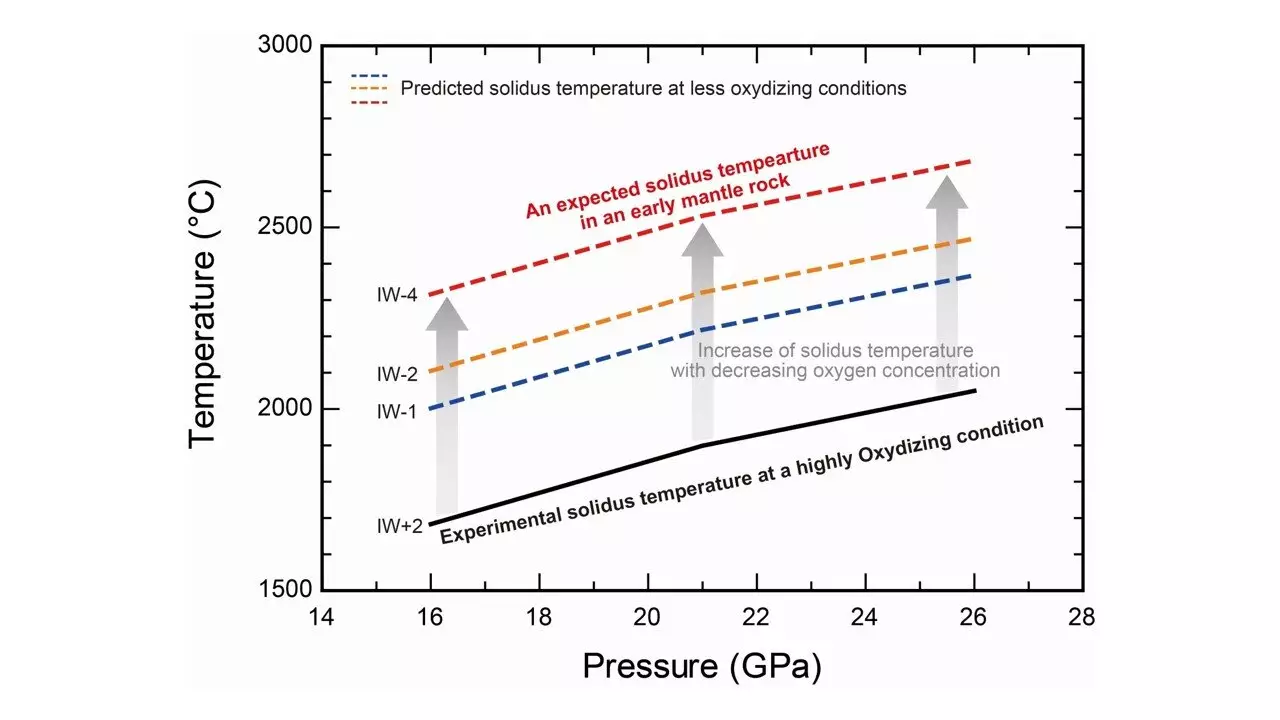The early Earth presents a captivating narrative of planetary formation, one that is characterized by its extreme conditions and volatile atmospheres. Central to this narrative is the concept of a global magma ocean, a vast expanse of molten rock that enveloped the planet during its formative years. Understanding the origin and characteristics of this magma ocean is integral to revealing the processes that shaped not only Earth but potentially other terrestrial bodies in the solar system. Recent research, spearheaded by an international team of scientists, highlights oxygen fugacity—essentially the amount of oxygen available in the mantle—as a critical factor influencing the melting temperatures of deep mantle rocks, thereby impacting our perception of early Earth’s evolution.
Theoretical Framework: Impacts and Heat Generation
The genesis of Earth’s magma ocean is attributed to the intense heat generated through the accretion of celestial bodies—small planets and asteroids colliding with a nascent Earth. This pervasive heat led to the widespread melting of the Earth’s surface, forming a molten ocean of rock. However, the dynamics of mantle materials under high-pressure conditions remain inadequately defined, primarily due to varying interpretations of melting temperatures. Earlier models largely relied on experimental results that now appear to conflict with newer findings, propelling scientists to re-evaluate their understanding of how deep Earth behaves under such primordial conditions.
A particularly intriguing aspect of this investigation is the role of oxygen fugacity in determining the melting temperatures of mantle rocks. Traditional models have typically underestimated the complexity of these interactions, asserting that pure compositional analysis would suffice to ascertain these thresholds. However, recent experiments indicate that as oxygen fugacity increases—likely due to geological processes such as core formation—the melting temperatures of mantle materials can differ significantly, by as much as 200 to 250 degrees Celsius. This revelation begs a re-examination of how melting manifestations in the Earth’s interior relate to surface processes and geological formations.
Research Methodology: A New Experimental Approach
The collaborative study led by Associate Professor Takayuki Ishii and Dr. Yanhao Lin made extensive use of high-pressure experimental techniques, subjecting samples of mantle pyrolite—a representative material of Earth’s mantle—to pressures that mirror conditions found 470 to 720 kilometers beneath the surface. At these depths, melting temperatures were comprehensively assessed under variably controlled oxygen fugacities. The results indicated a consistent trend: higher oxygen fugacities corresponded with a significant decrease in melting temperatures, underscoring that each logarithmic increase in oxygen fugacity results in a staggering deepening of the magma ocean’s floor by approximately 60 kilometers.
These findings hold vast implications for the prevailing models of early planetary evolution. The correlation between oxygen fugacity and melting temperatures fundamentally questions established beliefs about the thermal evolution of not only Earth but other rocky planets as well. Additionally, discrepancies observed in ancient magmatic rock formations—dating back over 3 billion years—become clearer when viewed through this renewed lens of oxygen fugacity. If the deep mantle exhibited low oxygen fugacity post-core formation, yet ancient magmas reveal high fugacities, it suggests a more complex history of oxygen dynamics influencing mantle evolution than previously understood.
The implications of this study extend beyond Earth, unlocking potential insights into the formation and evolution of other rocky planets, particularly those that may be capable of supporting human life. Understanding how oxygen fugacity influences mantle dynamics can illuminate the conditions necessary for habitability in exoplanets, potentially guiding future explorations in the search for extraterrestrial life.
This groundbreaking research encourages a critical reassessment of our existing models concerning early Earth processes, particularly concerning the formation and characteristics of the magma ocean. As we unveil the complexities surrounding oxygen fugacity’s role in these processes, we gain not only a clearer picture of our planet’s past but also valuable perspectives for exploring the geological behavior of other celestial bodies. Our journey towards understanding the nature of planetary evolution advances through such critical inquiries, weaving together the intricate tapestry of ecological and geophysical discovery.


Leave a Reply